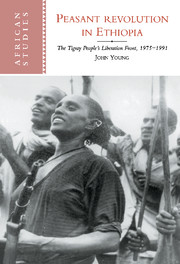Book contents
- Frontmatter
- Contents
- List of maps
- A note on names, transliteration and the Ethiopian Calendar
- Acknowledgements
- 1 Ethiopia
- Introduction
- 1 Peasants and revolutions: theoretical directions
- 2 Historical and social background
- 3 Tigray on the eve of insurrection
- 4 Struggle for opposition ascendancy: 1975–1978
- 5 Challenges and advances: 1978–1985
- 6 Triumph 1985–1991
- 7 TPLF and the peasants
- 8 Conclusion
- Notes
- Bibliography
- Index
- Titles in the series
6 - Triumph 1985–1991
Published online by Cambridge University Press: 12 November 2009
- Frontmatter
- Contents
- List of maps
- A note on names, transliteration and the Ethiopian Calendar
- Acknowledgements
- 1 Ethiopia
- Introduction
- 1 Peasants and revolutions: theoretical directions
- 2 Historical and social background
- 3 Tigray on the eve of insurrection
- 4 Struggle for opposition ascendancy: 1975–1978
- 5 Challenges and advances: 1978–1985
- 6 Triumph 1985–1991
- 7 TPLF and the peasants
- 8 Conclusion
- Notes
- Bibliography
- Index
- Titles in the series
Summary
Introduction
The TPLF entered the final period of the war against the Derg weakened by the famine which disrupted the peasant economy and diverted energies away from mobilisation and military campaigns, to relief and later reconstruction. But by this point in time the TPLF and peasants were united in struggle, and with the passing of the famine many peasants were able to resume their livelihoods and continue their support of the guerrilla fighters in their midst. Thus the TPLF was soon focused on the key elements of this stage of the struggle: confronting the Derg's plans to forcibly remove its peasant supporters; taking the revolution to the heterogeneous peoples of southern Tigray; and resolving political disagreements with the EPLF in preparation for the removal of the Derg from Tigray and the country.
The Derg's resettlement programme
The Derg's war against the liberation movements had many dimensions: military campaigns; reform programmes to win the support of civilians; and efforts to isolate peasants from the appeal of dissidents, such as its resettlement programme. Because of the extent of environmental degradation and poverty in the northern provinces, proposals had frequently been made by a variety of sources to relocate northern peasants to the richer and less populated lands in the south. Indeed, between 1950 and 1974 an estimated one million peasants voluntarily left the northern highlands and moved to the south and west of the country, and what evidence there is suggests that Tigray had the largest net outflows of any of the provinces.
- Type
- Chapter
- Information
- Peasant Revolution in EthiopiaThe Tigray People's Liberation Front, 1975–1991, pp. 145 - 171Publisher: Cambridge University PressPrint publication year: 1997

